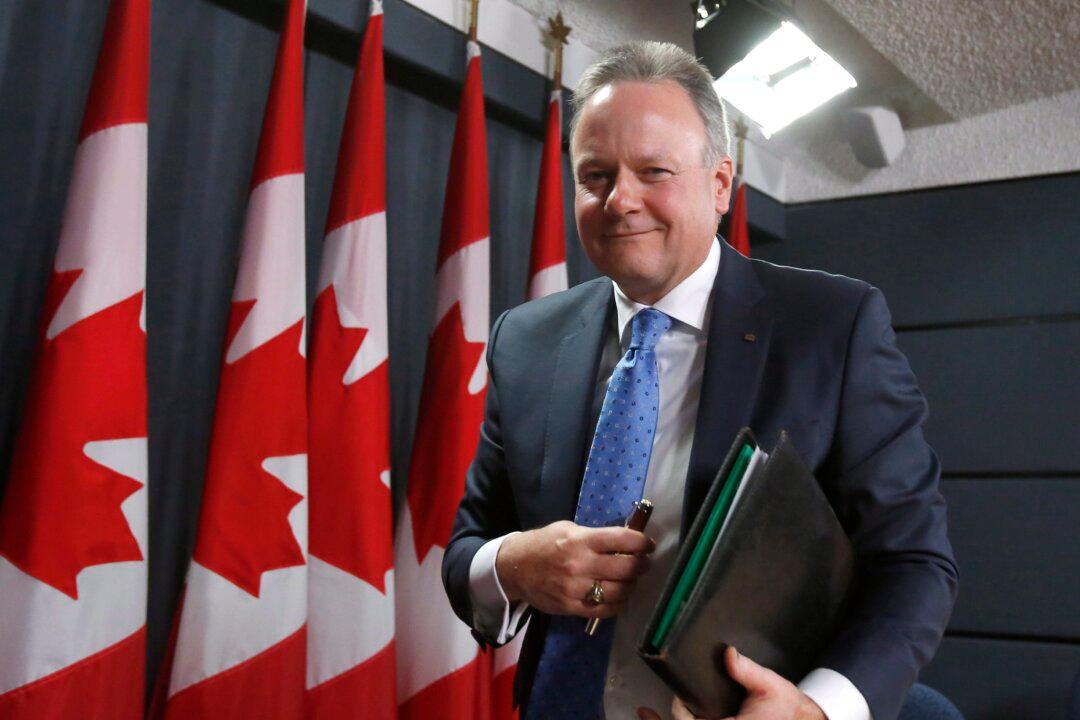OTTAWA—The Bank of Canada left the overnight rate at 0.75 percent on April 15, expecting the economy to rebound strongly in the second half of 2015.
The first quarter appears to have been a write-off, but the Bank deemed that no further “insurance” is necessary as it anticipates a similar rebound in the U.S., dissipation of the impact of the oil price shock, and more favourable financial conditions globally—factors that it believes will help Canada’s economy get back on track.
The BoC was not expected to make any changes to rates in its latest decision, although it did surprise markets in January with the rate cut to 0.75 percent.
As the Canadian economy continues to come to grips with the oil price shock, the BoC’s assessment is that “The impact of the oil price shock on growth will be more front-loaded than predicted in January, but not larger.”
“The Canadian economy is estimated to have stalled in the first quarter of 2015,” said the Bank of Canada in its interest rate decision press release. No real GDP growth is expected (i.e. 0.0 percent) for the first quarter of 2015, as compared to 1.5 percent in January’s projections.
“The key issue for us is, is the oil price shock having a bigger effect or just a faster effect?” said Bank of Canada governor Stephen Poloz at a press conference following the interest rate announcement along with the release of the latest Monetary Policy Report (MPR).
The BoC expects a significant rebound in the third quarter (2.8 percent real GDP growth versus 2.0 percent projected in January). The second quarter got a slight upgrade from January’s projections as well (1.8 percent versus 1.5 percent).
The Bank expects real GDP growth to average about 2.5 percent per quarter until the middle of 2016 before it falls closer to 2.1 percent by late 2016—a modest downgrade from January’s projections.
The weaker-than-expected first quarter has put more downward pressure on inflation. Core inflation is projected to be very stable around 2.0 percent. Total consumer price index (CPI), however, which factors in the fall in gasoline prices, is projected to dip below the lower bound of the 1 to 3 percent inflation target range before getting back to target in early 2016.
“Now the key is whether the economy continues to disappoint in the months ahead—if it looks to seriously undershoot the Bank’s expectation of nearly 2.5 percent growth over the next three quarters, another rate cut could be back on the table,” said BMO in a statement about the Bank of Canada’s announcement.
Cause for Optimism
The Bank believes the labour market is improving, but cautions that much slack still remains and the full impact from oil prices has yet to show up in employment statistics.
“They’re early signs, there’s a long way to go,” said Senior Deputy Governor Carolyn Wilkins.
“It’s that sense of churn and better matching,” Poloz explained. “The participation rate is rising so we’re getting a little more optimistic. Those are the precursors to a true improvement in the labour market.”
With these signs of healing in the labour market, there is a greater chance that people who may lose their jobs in the oil patch will find alternative employment in another sector than, say, a year ago.
Non-Energy Exports Lead the Way
Financial conditions—lower currency and interest rates—are positives for the Canadian economy. Globally, central banks have been battling low inflation and weak growth prospects. More than 25 central banks representing over half the world’s GDP have lowered policy rates or undertaken quantitative easing since the start of 2015.
But one economy not in easing mode is the U.S., and it is a one of the sources of support for the Canadian economy. The Bank expects strong growth south of the border in the second quarter of 2015 despite also suffering a poor first quarter.
The Fed’s March projections for GDP growth were revised lower with 2015 estimates between 2.3 and 2.7 percent. This is lower than the BoC projected in January (3.2 percent). The BoC now projects U.S. growth for 2015 at 2.7 percent.
As the U.S. economy recovers from a harsh winter and port strike in Los Angeles, the non-energy exports sector in Canada should strengthen. Items such as aircraft and parts, machinery, and metal products lead the strength in the non-energy exports sector.





